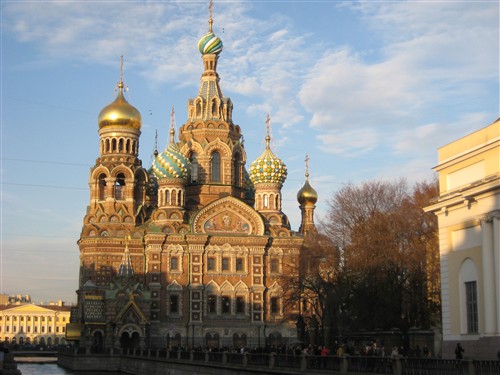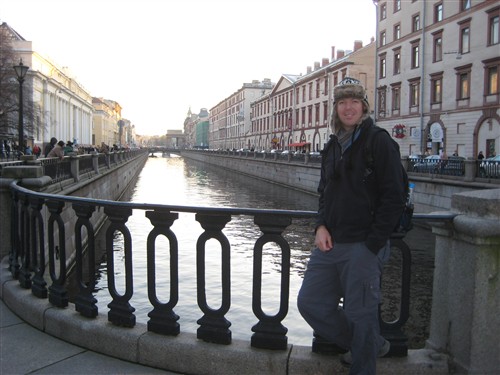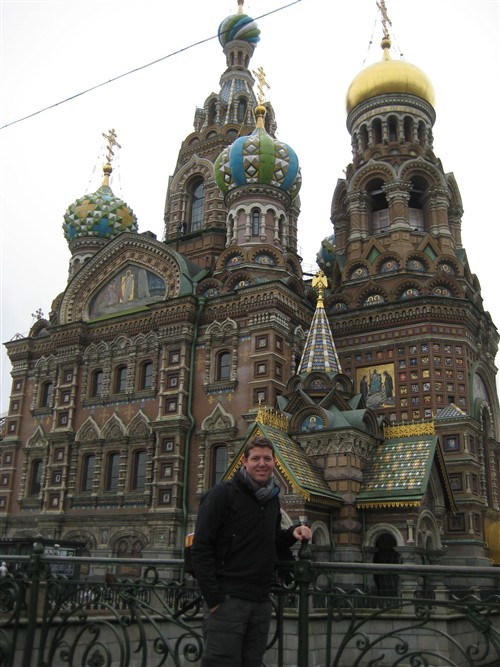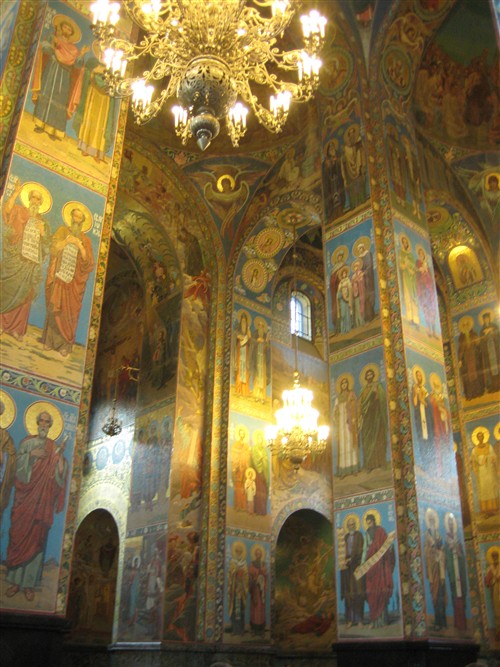Posted under Russia

Famous for vodka, oil communism and gangsters, we felt confident that Russia would be a powerful conclusion to our round-the-world adventure. With our knowledge of the world’s largest country limited to its political history, its reputation as a bureaucratic abyss, and its recent cameos in the world media, and, of course, Hollywood, our illusions of Russian culture were mysteriously opaque.
Finding our way from the airport in Saint Petersburg to our hostel in the city center was, ready or not, our first opportunity to test the infrastructure. We caught a bus from the airport to the city center and quickly concluded, as we looked for our stop, that Russia has less English-language signage than any other country that we have visited. The Russian alphabet, known as Cyrillic and adopted from Bulgaria, seems to be a hybrid of Greek and Roman characters. Though most of the signage is in Russian, one can, with a basic knowledge of the Greek alphabet, decipher just enough of it to survive.
 From the bus stop, we struggled a bit to find the metro station but eventually found ourselves descending into the cavernous recesses of the underground railway system. Disconcerted by the lack of metro maps around the stations, we did find one map that listed the stops in both English and Russian characters. We were astonished by the frequency of the trains – arriving every minute-and-a-half or so compared to the five-to-seven minute intervals in other busy international cities – and also by the masses of riders on each train.
From the bus stop, we struggled a bit to find the metro station but eventually found ourselves descending into the cavernous recesses of the underground railway system. Disconcerted by the lack of metro maps around the stations, we did find one map that listed the stops in both English and Russian characters. We were astonished by the frequency of the trains – arriving every minute-and-a-half or so compared to the five-to-seven minute intervals in other busy international cities – and also by the masses of riders on each train.
Our hostel was located a few blocks off of Nevsky Prospekt – Saint Petersburg’s main shopping thoroughfare. It was several blocks walking from the metro stop, during which we immediately noticed the inadequate number of crosswalks over the busy six-to-eight lane streets. By the time we reached the wrought-iron security gate of our building, I was cursing the albatross on my back. Once inside, we climbed a single set of filthy cement stairs that reeked of sewage and stepped into a tiny, warm reception area. Thankfully, the check-in process was brief and we were soon shown to a small cell with two metal twin beds and some other plain furnishings. The place screamed communism and seemed both frighteningly and delightfully appropriate. It didn’t take us long to spread out our meager but warmly familiar possessions and make ourselves at home. It was already late afternoon but, as it has been on our first day in almost every new city, we were anxious to get out and explore.
Often called the “Venice of the North”, Saint Petersburg has a super-sized European feel with large Italianate mansions and juxtaposed buildings along wide canal streets. It is Europe on steroids.

People-watching on Nevsky Prospekt was fascinating! Largely due to the “pain-in-the-ass” factor of getting a Russian visa, there are very few foreign tourists on the streets. Add to that the fall-that-feels-like-winter weather and you have Saint Petersburg almost all to yourself. Upon first walking around the city, one cannot help but admire the beauty of the young Russian women. They all seem to have gorgeous long hair, ice-blue eyes, and never-ending legs with tall stiletto-heeled boots. You don’t see an athletic shoe on anyone – only black or brown leather dress shoes. Fashion is highly embellished with stones, studs and shiny accessories. P.E.T.A. supporters beware: fur is very much in vogue. Everyone who can afford to wear it, does.
There is a noticeable military and police presence in Saint Petersburg. We must have seen five different types of uniforms on our first day alone. Naturally, I wanted photos of all of the officers but their cold, serious facial expressions and rumors of corruption have so far left me uncharacteristically timid. We have already heard stories from other travelers about police harassment and, for the first time in fourteen months, we are wearing our passports on our persons. So far, we have not received even a sideways glance but are keeping our heads down nonetheless.
 That afternoon, we were headed toward the Church on the Spilled Blood, constructed on the spot where Alexander II, Emperor of Russia, was mortally wounded in 1881. Built from 1883 – 1907, the colorful, onion-domed church contrasts the city’s overwhelmingly baroque style though it manifests the quintessential style of Russian Orthodox churches of the 17th century.
That afternoon, we were headed toward the Church on the Spilled Blood, constructed on the spot where Alexander II, Emperor of Russia, was mortally wounded in 1881. Built from 1883 – 1907, the colorful, onion-domed church contrasts the city’s overwhelmingly baroque style though it manifests the quintessential style of Russian Orthodox churches of the 17th century.
As we turned the corner from Nevsky Prospekt onto the canal street that ran along the church, we spotted a handgun sitting unattended on the outside window sill of a gift shop. We looked around, suspiciously, but no one else seemed to notice it. We certainly were NOT going to touch it! “Welcome to Russia!” we laughed, as we walked on toward the church.
The sun was already setting and a third of the church’s magnificent façade was already cast in shadow so we snapped a few quick pictures outside and then walked around back to the entrance.
 At first glance, the interior walls looked to be covered in soft, golden murals but we soon realized that the medium was mosaic. Scenes from the New Testament in beautiful, bright-colored mosaic ran from the semi-precious stone base to the ceiling, covering every window frame, support beam and arch. The arrangement of the subjects in the mosaics corresponded to the canons of Orthodox iconography. The southern wall portrayed the Nativity and the Baptism of Christ. The northern wall was devoted to scenes of the miracles performed by the Savior. The western wall featured scenes from the Passion. The iconostasis was a masterwork of lace-cut Italian marble. The floor, made from various kinds of Italian marble, was designed to look like a mosaic carpet.
At first glance, the interior walls looked to be covered in soft, golden murals but we soon realized that the medium was mosaic. Scenes from the New Testament in beautiful, bright-colored mosaic ran from the semi-precious stone base to the ceiling, covering every window frame, support beam and arch. The arrangement of the subjects in the mosaics corresponded to the canons of Orthodox iconography. The southern wall portrayed the Nativity and the Baptism of Christ. The northern wall was devoted to scenes of the miracles performed by the Savior. The western wall featured scenes from the Passion. The iconostasis was a masterwork of lace-cut Italian marble. The floor, made from various kinds of Italian marble, was designed to look like a mosaic carpet.
Prior to 1917, the church was used solely for commemoration services for the departed Alexander II. In 1917, it became a regular parish church but, in 1930, it was closed and used for storage. For forty years, this magnificent church was used to store potatoes! Oh, the humanity. Finally, in 1970, restoration work began and the church was opened as a museum in 1997. The Church on the Spilled Blood is truly an awe-inspiring masterpiece and it is unfortunate that a place of such divine beauty is not used for religious services, though, in judging by the admission price, its current use is the more lucrative one.
So far, Russia is every bit as intriguing as we dreamed it would be. With five more nights in Saint Petersburg – the country’s cultural capital – there is just no telling what other discoveries lay in store.
2 Responses to “Mother Russia”

Lizzi on 29 Oct 2008 at 7:47 am #
I’m counting down the days Tini. I can’t wait for you to come home.
XOXO,
Liz
Andrew Leonard on 29 Oct 2008 at 9:11 pm #
That looks beautiful! McDonald’s that is 😉 Drink some vodka, stand in line hours for TP, and bring me back one of those furry little hats!!!
Cheers!